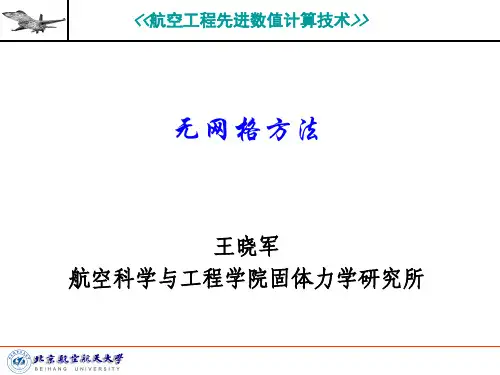无网格方法.ppt
- 格式:pptx
- 大小:4.78 MB
- 文档页数:14



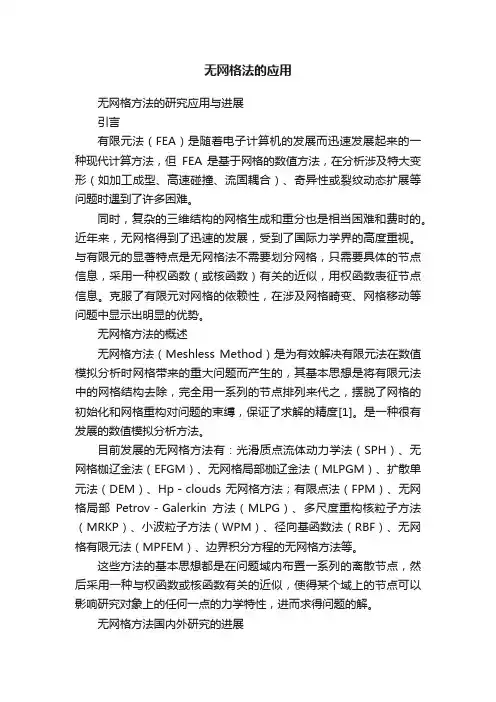
无网格法的应用无网格方法的研究应用与进展引言有限元法(FEA)是随着电子计算机的发展而迅速发展起来的一种现代计算方法,但FEA 是基于网格的数值方法,在分析涉及特大变形(如加工成型、高速碰撞、流固耦合)、奇异性或裂纹动态扩展等问题时遇到了许多困难。
同时,复杂的三维结构的网格生成和重分也是相当困难和费时的。
近年来,无网格得到了迅速的发展,受到了国际力学界的高度重视。
与有限元的显著特点是无网格法不需要划分网格,只需要具体的节点信息,采用一种权函数(或核函数)有关的近似,用权函数表征节点信息。
克服了有限元对网格的依赖性,在涉及网格畸变、网格移动等问题中显示出明显的优势。
无网格方法的概述无网格方法(Meshless Method)是为有效解决有限元法在数值模拟分析时网格带来的重大问题而产生的,其基本思想是将有限元法中的网格结构去除,完全用一系列的节点排列来代之,摆脱了网格的初始化和网格重构对问题的束缚,保证了求解的精度[1]。
是一种很有发展的数值模拟分析方法。
目前发展的无网格方法有:光滑质点流体动力学法(SPH)、无网格枷辽金法(EFGM)、无网格局部枷辽金法(MLPGM)、扩散单元法(DEM)、Hp-clouds 无网格方法;有限点法(FPM)、无网格局部Petrov-Galerkin方法(MLPG)、多尺度重构核粒子方法(MRKP)、小波粒子方法(WPM)、径向基函数法(RBF)、无网格有限元法(MPFEM)、边界积分方程的无网格方法等。
这些方法的基本思想都是在问题域内布置一系列的离散节点,然后采用一种与权函数或核函数有关的近似,使得某个域上的节点可以影响研究对象上的任何一点的力学特性,进而求得问题的解。
无网格方法国内外研究的进展无网格法起源于20 世纪70 年代。
Perrone,Kao 最早采用任意网格技术将传统有限差分进行扩展,提出了有限差分法,这可看作无网格技术的最初萌芽。
1977年Lucy 和Monaghan 首次提出了基于拉格朗日公式的光滑质点流体动力法(Smoothed Particle Hydrocynamics:SPH),这是一种纯拉格朗日法,无需网格。

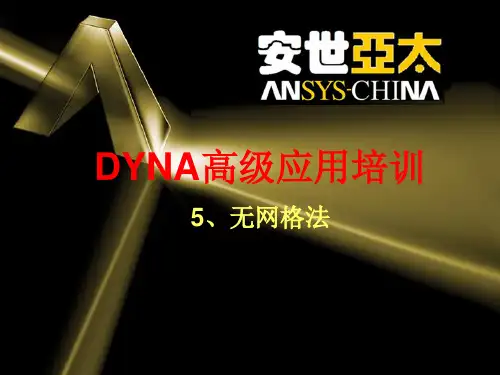
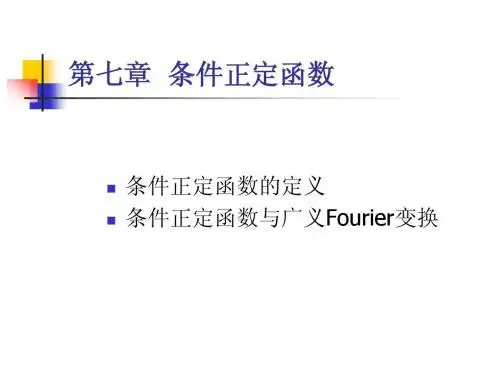


无网格法典型无网格法V伽辽金型无网格法V配点型无网格法V基于局部弱形式和边界积分方程的无网格法V最小二乘无网格法V物质点法V EFG¾MLS¾Galerkin V RKPM¾RK¾Galerkin V PIM¾PIG l ki¾Galerkin等效积分弱形式(虚位移原理)MLS 近似:()()u =x N x dV 计算量大精度高稳定性V 精度高,稳定性好V 需要背景网格进行积分V 系数矩阵对称V 不易施加本质边界条件处理V背景网格积分,,d I i J j N N ΩΩ∫()()()()=ΔΩ+ΔΓP N x f x N x t x 11I I I I I II I ==∑∑零能模态V 单位分解积分11.函数ψk (x )只定义在子域Ωk 上;2.子域Ωk 相互重叠,且它们完全覆盖了域Ω;3l=3.函数ψk (x )满足单位分解条件1()d ()()d k k k f f ψΩΩ∩Ω=ΩΩ∑∫∫x x x配点型无网格法V FPM¾MLS¾CollocationV SPH¾KA¾Collocationp es ess c ouds V Hp meshless clouds ¾PUC ll ti¾Collocation基于局部弱形式和边界积分方程的无网格法V MLPG¾MLS¾LPGV LBIE¾MLS¾LBIENV BNM¾MLS¾BIEgn pn 1iI IJ iJJ p m v ==∑1IJ p Ip Jpp m m N N ==∑质量阵求逆iIp iJv?质量阵求逆!gpn n 11I IJ p IpJ p m m m N ====∑∑对角质量阵iI I iIp m v =V已知t k 时刻的物理量,求t k +1时刻的物理量11.更新网格结点数据kk Ip Ipm m N=∑ppn k k kiIip Ip p m v N=1p ppp =∑int,ext,kk k iI iIiIf ff=−2.在背景网格结点上积分动量方程并施加固定边界条件1k k k pp f t+=+ΔiIiI iI10,0k k iIiIp f +==在固定边界上6.更新密度,应力k k k 1/(1)p p iipρρε+=+Δ1k k kkij ij ij ij+=ijpijp ijp ijp r σσσ+Δ+Δkk k kk r σσΔ=ΔΩ−ΔΩ其中ijpijpijpijpijpk ijpσΔ根据弹塑性本构关系更新7.进行下一个时间步循环。
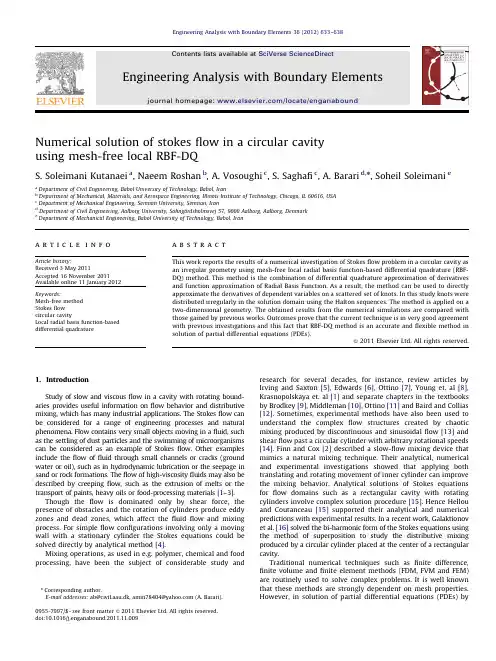
Numerical solution of stokesflow in a circular cavityusing mesh-free local RBF-DQS.Soleimani Kutanaei a,Naeem Roshan b,A.Vosoughi c,S.Saghafic,A.Barari d,n,Soheil Soleimani ea Department of Civil Engineering,Babol University of Technology,Babol,Iranb Department of Mechanical,Materials,and Aerospace Engineering,Illinois Institute of Technology,Chicago,IL60616,USAc Department of Mechanical Engineering,Semnan University,Semnan,Irand Department of Civil Engineering,Aalborg University,Sohng˚a rdsholmsvej57,9000Aalborg,Aalborg,Denmarke Department of Mechanical Engineering,Babol University of Technology,Babol,Irana r t i c l e i n f oArticle history:Received3May2011Accepted16November2011Available online11January2012Keywords:Mesh-free methodStokesflowcircular cavityLocal radial basis function-baseddifferential quadraturea b s t r a c tThis work reports the results of a numerical investigation of Stokesflow problem in a circular cavity asan irregular geometry using mesh-free local radial basis function-based differential quadrature(RBF-DQ)method.This method is the combination of differential quadrature approximation of derivativesand function approximation of Radial Basis Function.As a result,the method can be used to directlyapproximate the derivatives of dependent variables on a scattered set of knots.In this study knots weredistributed irregularly in the solution domain using the Halton sequences.The method is applied on atwo-dimensional geometry.The obtained results from the numerical simulations are compared withthose gained by previous works.Outcomes prove that the current technique is in very good agreementwith previous investigations and this fact that RBF-DQ method is an accurate andflexible method insolution of partial differential equations(PDEs).&2011Elsevier Ltd.All rights reserved.1.IntroductionStudy of slow and viscousflow in a cavity with rotating bound-aries provides useful information onflow behavior and distributivemixing,which has many industrial applications.The Stokesflow canbe considered for a range of engineering processes and naturalphenomena.Flow contains very small objects moving in afluid,suchas the settling of dust particles and the swimming of microorganismscan be considered as an example of Stokesflow.Other examplesinclude theflow offluid through small channels or cracks(groundwater or oil),such as in hydrodynamic lubrication or the seepage insand or rock formations.Theflow of high-viscosityfluids may also bedescribed by creepingflow,such as the extrusion of melts or thetransport of paints,heavy oils or food-processing materials[1–3].Though theflow is dominated only by shear force,thepresence of obstacles and the rotation of cylinders produce eddyzones and dead zones,which affect thefluidflow and mixingprocess.For simpleflow configurations involving only a movingwall with a stationary cylinder the Stokes equations could besolved directly by analytical method[4].Mixing operations,as used in e.g.polymer,chemical and foodprocessing,have been the subject of considerable study andresearch for several decades,for instance,review articles byIrving and Saxton[5],Edwards[6],Ottino[7],Young et.al[8],Krasnopolskaya et.al[1]and separate chapters in the textbooksby Brodkey[9],Middleman[10],Ottino[11]and Baird and Collias[12].Sometimes,experimental methods have also been used tounderstand the complexflow structures created by chaoticmixing produced by discontinuous and sinusoidalflow[13]andshearflow past a circular cylinder with arbitrary rotational speeds[14].Finn and Cox[2]described a slow-flow mixing device thatmimics a natural mixing technique.Their analytical,numericaland experimental investigations showed that applying bothtranslating and rotating movement of inner cylinder can improvethe mixing behavior.Analytical solutions of Stokes equationsforflow domains such as a rectangular cavity with rotatingcylinders involve complex solution procedure[15].Hence Hellouand Coutanceau[15]supported their analytical and numericalpredictions with experimental results.In a recent work,Galaktionovet al.[16]solved the bi-harmonic form of the Stokes equations usingthe method of superposition to study the distributive mixingproduced by a circular cylinder placed at the center of a rectangularcavity.Traditional numerical techniques such asfinite difference,finite volume andfinite element methods(FDM,FVM and FEM)are routinely used to solve complex problems.It is well knownthat these methods are strongly dependent on mesh properties.However,in solution of partial differential equations(PDEs)byContents lists available at SciVerse ScienceDirectjournal homepage:/locate/enganaboundEngineering Analysis with Boundary Elements0955-7997/$-see front matter&2011Elsevier Ltd.All rights reserved.doi:10.1016/j.enganabound.2011.11.009n Corresponding author.E-mail addresses:ab@civil.aau.dk,amin78404@(A.Barari).Engineering Analysis with Boundary Elements36(2012)633–638these methods for complex geometries,mesh generation takes up very much time and is the most expensive part of the simulation.In light of difficulties of the meshing-related issues various mesh-free methods have been developed.Among them are the smooth particle hydrodynamics (SPH)[17],meshless local Petrov–Galerkin approach (MLPG)[18,19],least-squares mesh-free method (LSMFM)[20,21],etc.Recently,a new mesh-free method is proposed based on the so-called radial basis functions (RBF)[22–24].Kansa [23–24]introduced the direct collocation method using RBFs.It is found that RBFs are able to construct an interpolation scheme with favorable properties such as high efficiency,good quality and capability of dealing with scattered data,especially for higher dimension problems.The ‘‘truly’’mesh-free nature of RBFs motivated researchers to use them to deal with partial differential equations.It should be noted that the Kansa’s RBF method is actually based on the function approximation.To approximate derivatives by using RBFs,Shu and co-workers [25–27]proposed the RBF-DQ method,which combines the differential quadrature (DQ)approximation [28,29]of derivatives and function approximation of RBF.Previous applications [25–27,30–34]showed that RBF-DQ is an efficient method to solve fluid flow,heat transfer,linear and nonlinear PDEs and proved that the local RBF-DQ method is very flexible,simple in code writing and it can be easily applied to linear and nonlinear problems.In this method the problem of ill-conditioned global matrix has been removed by replacement of global solvers by block partitioning schemes for large simulation problems as shown in Fig.1.In this study the mesh-free local RBF-DQ method is applied to obtain the flow characteristics in a circular rotating cavity.Outcomes reveal that current technique is in good agreement with previous works have been done using other numerical methods,namely finite element method (FEM)and boundary element method (BEM).1.1.Radial basis functionsA radial basis function,denoted by j ð:x Àx j :2Þ,is a continuous spline,which depends on the separation distances of a subset of scattered points x A R d ,in which d denotes the spatial dimension.The most commonly used RBF isMultiquadrics ðMQ Þ:j ðr Þ¼ffiffiffiffiffiffiffiffiffiffiffiffiffiffir 2þc 2p ,c 40ð1Þwhere r ¼:x Àx j :2.For scattered points the approximation of afunction f (x )can be written as a linear combination of N RBFs:f ðx ÞffiX N j ¼1l j j ð:x Àx j :2Þþc ðx Þ,ð2Þwhere N is the number of centers or knots x ,x ¼(x 1,x 2,...,x d ),d isthe dimension of the problem,l ’s are coefficients to be determined and j is the RBF.If C d q denotes the space of d -variate polynomials of order not exceeding q ,and letting the polynomials letting thepolynomials P 1,...,P m be the basis of C d q in R d,then the polynomial c (x ),in Eq.(2),is usually written in the following form:c ðx Þ¼X m 1z i P i ðx Þ,ð3Þwhere m ¼(q À1þd )!/(d !(q À1)!).To determine the coefficients(l 1,y ,l N )and (z 1,y ,z N ),extra m equations are required in addition to the N equations resulting from the collocating Eq.(5)at the N knots.This is insured by the m conditions for Eq.(5),that isX N j ¼1l j P i ðx j Þ¼0,i ¼1,...,m :ð4Þ1.2.Differential quadrature method (DQ)The essence of the DQ method is that the partial derivative of an unknown function with respect to an independent variable can be approximated by a linear weighted sum of functional values at all mesh points in that direction.Suppose that a function f (x )is sufficiently smooth.Then its m th order derivative with respect to x at a point x i can be approximated by DQ as f ðm Þx ðx i Þ¼X N j ¼1w m ij f ðx j Þ,i ¼1,2,...,N ,ð5Þwhere x j are the discrete points in the domain;f (x j )and w ðm Þijare the function values at these points and the related weighting coefficients,respectively.One of the most important advantages of the DQ method as a global (high order)approach,in compar-ison with the low order methods such as FV or FD,is its ability to generate numerical results with high order of accuracy by using a considerably small number of mesh points.1.3.Local MQ-DQ method formulationSuppose that the solution of a partial differential equation iscontinuous,which can be approximated by MQ RBFs,and only a constant is included in the polynomial term c (x ).Then,the function in the domain can be approximated by MQ RBFs as f ðx ,y Þ¼X N j ¼1l j ffiffiffiffiffiffiffiffiffiffiffiffiffiffiffiffiffiffiffiffiffiffiffiffiffiffiffiffiffiffiffiffiffiffiffiffiffiffiffiffiffiffiffiffiffiðx Àx j Þ2þðy Ày j Þ2þc 2j q þl N þ1:ð6ÞTo make the problem be well-posed,one more equation isrequired.From Eq.(4),we haveX N j ¼1l j ¼0)l i ¼ÀX N j ¼1,j a il j :ð7ÞSubstituting Eq.(7)into Eq.(6)gives f ðx ,y Þ¼X N j ¼1,j a il j g j ðx ,y Þþl N þ1,ð8Þwhereg j ðx ,y Þ¼ffiffiffiffiffiffiffiffiffiffiffiffiffiffiffiffiffiffiffiffiffiffiffiffiffiffiffiffiffiffiffiffiffiffiffiffiffiffiffiffiffiffiffiffiffiðx Àx j Þ2þðy Ày j Þ2þc 2j q Àffiffiffiffiffiffiffiffiffiffiffiffiffiffiffiffiffiffiffiffiffiffiffiffiffiffiffiffiffiffiffiffiffiffiffiffiffiffiffiffiffiffiffiffiffiðx Àx i Þ2þðy Ày i Þ2þc 2iq ,ð9Þl N þ1can be replaced by l i and Eq.(8)can be written asf ðx ,y Þ¼X N j ¼1,j a il j g j ðx ,y Þþl i :ð10Þf (x ,y )in Eq.(10)constitutes N -dimensional linear vector space V Nwith respect to the operation of addition andmultiplication.Fig.1.Supporting knots around a centered knot.S.Soleimani Kutanaei et al./Engineering Analysis with Boundary Elements 36(2012)633–638634Substituting all the base functions into Eq.(5),we have0¼X Nk¼1w mðÞi,k,ð11Þ@m g jðx i,y iÞ@x m ¼X Nk¼1wðnÞi,kg jðx k,y kÞ,j¼1,2,...,N,but j a i:ð12ÞFor the given i,equation system(11)–(12)has N unknowns with N equations.Therefore,solving this equation system canobtain the weighting coefficients wðmÞik .From Eq.(9),one can easilyobtain thefirst order derivative of g j(x,y)as@g jðx i,y iÞ@x ¼xÀx jffiffiffiffiffiffiffiffiffiffiffiffiffiffiffiffiffiffiffiffiffiffiffiffiffiffiffiffiffiffiffiffiffiffiffiffiffiffiffiffiffiffiffiffiffiðxÀx jÞ2þðyÀy jÞ2þc2jqÀxÀx iffiffiffiffiffiffiffiffiffiffiffiffiffiffiffiffiffiffiffiffiffiffiffiffiffiffiffiffiffiffiffiffiffiffiffiffiffiffiffiffiffiffiffiffiffiðxÀx iÞ2þðyÀy iÞ2þc2iqð13ÞIn the matrix form,the weighting coefficient matrix of the x-derivative can then be determined by½G ½W n T¼f G x g,ð14Þwhere[W n]T is the transpose of the weighting coefficient matrix [W n],and½W m ¼wðmÞ1,1wðmÞ1,2:::wðmÞ1,NwðmÞ2,1wðmÞ2,2:::w mðÞ2,N ^^&^wðmÞN,1wðmÞN,2:::wðmÞN,N26666643777775,½G ¼11 (1)g1ðx1,y1Þg1ðx2,y2Þ...g1ðx N,y NÞ^^&g Nðx1,y1Þg Nðx2,y2Þ...g Nðx N,y NÞ266664377775,½G x ¼00ÁÁÁ0g mxð1,1Þg mxð1,2ÞÁÁÁg mxð1,NÞ^^&g mxðN,1Þg mxðN,2Þ...g mxðN,NÞ266664377775:ð15ÞWith the known matrices[G]and[G x],the weighting coeffi-cient matrix of x-derivative[W m]can be obtained by using a direct or iterative method such as LU decomposition or SOR.The weighting coefficient matrix of the y-derivative can be obtained in a similar ing these weighting coefficients,we can discretize the spatial derivatives and transform the governing equations into a system of algebraic equations,which can be solved by iterative or direct method.1.4.Shape parameter(c)in local MQ-DQ methodAs mentioned before,the MQ approximation of the function contains a shape parameter C that could be knot-dependent and must be determined by the user.In our study,c is chosen as a constant,and is taken as0.12,and the number of supporting knots is taken as16based on the previous work of Ding et al.[26].2.Mathematical modelingConsidered geometry of the problem with related boundary condition is depicted in Fig.2.The continuity and dimensionless form of the Navier–Stokes equations for a Newtonian viscousfluid of constant density and constant viscosity are as follows:r u¼0ð16ÞSt @u@tþðu U rÞu¼ÀEu r Pþ1Rer2uþ1Fr2gð17Þwhere u¼(u,v,w)is the velocity vector,P is the pressure,g is theexternal body force,St is Strouhal number,Eu is Euler number,Reis Reynolds number and Fr is Froude number.In theflow offluids,a Reynolds number(densityÂlengthÂvelocity/viscosity)describes the relative importance of inertiaeffects to viscous effects.Forflows with very small(less than1)Reynolds number the inertia effects can be ignored in comparisonto the viscous resistance.These kinds offlows are known asStokesflow or creepingflow.The general form of momentumequation for stokesflow while Fr51is shown below:St@u@t¼ÀEu r Pþ1Rer2uð18ÞFor the cases in which the rate of change in the velocityfielddue to geometrical changes is much smaller than viscous diffu-sion(StÂRe51),the momentum equation can be reduced tosteady form asm r2u¼r Pð19Þsubjected to the following no-slip boundary conditions:u¼Uð20Þwhere m is the dynamic viscosity and U is known a prioriboundary velocity.Eqs.(16),(19)and(20)constitute the so calledprimitive variables of velocity–pressure formulation.By defini-tion,the vorticity vector X¼(x,Z,z)is expressed asX¼rÂuð21ÞTaking the curl to Eq.(19)with constant m,and using Eq.(21),we obtain the steady-state vorticity transport equation for Stokesflows as follows:r2X¼0ð22ÞTaking the curl to Eq.(19)and using Eq.(16),we getr2u¼ÀrÂXð23ÞSubstituting Eq.(23)in Eq.(19)with taking the divergenceoperator,we can obtainr2P¼0ð24ÞEqs.(22)–(24)are the governing equations for steady stateStokesflows in another form known as the velocity–vorticityformulation.Fig.2.Geometry and boundary conditions.S.Soleimani Kutanaei et al./Engineering Analysis with Boundary Elements36(2012)633–638635In two dimensional if (u ,v )are the velocity vectors and o is the associated vorticity vector,then we haver 2o ¼0ð25Þr 2u ¼À@o @yð26Þr 2v ¼@o @xð27Þ3.Results and discussionAn iterative procedure is applied to the velocity–vorticity formulation of Stokes flow.In the present work,the velocity Poisson equations are first solved to obtain the vorticity boundary conditions that are used in the solution of the vorticity Laplace equation.The solution procedure is described in the following steps:1.Solve the discretized form of velocity Poisson Eqs.(26)and (27)using the SOR.Discritizing of space derivation for Eqs.(26)and (27)using local RBF-DQ is gained as follows:X n i k ¼1w 2x i ,k u k i þX n i k ¼1w 2y i ,k u k i¼ÀX n i k ¼1w 1y i ,k o kið28ÞX n i k ¼1w 2x i ,k v ki þX n ik ¼1w 2y i ,k v ki¼X n ik ¼1w 1x i ,k v k ið29Þ2.Calculate the velocity distribution and velocity derivatives atall nodal points.3.Determine new vorticity boundary values using the definition of vorticity in Eq.(21).4.Solve the vorticity Laplace Eq.(25)using iterative local RBF-DQX n i k ¼1w 2xi ,koki þX n i k ¼1w 2y i ,k o ki¼0ð30Þ5.Calculate the unknown vorticity values throughout the domain.6.Calculate the derivatives of the vorticity vectors to be used in the velocity Poisson equations.7.Check for the convergence of the velocity and vorticity components (the convergence criterion is set to 10À6).8.If the convergence criterion is satisfied,then stop;otherwise go to Step 1.Point generation in the present method is consequently easier in complex domains as compared with mesh-based methods.In general,there are three grid generation algorithms that can be selected according to the practical applications [35]:(1)Using the grid generation algorithm of conventional finite-difference schemes for simple geometries.(2)Using the random point generation algorithm.(3)Using algebraic formulation to produce several layers oflocally orthogonal grids near the boundary,and using the random point generation algorithm to generate other nodes.A comparison on the CPU time of the solution procedure employing the points generated by the second and the third algorithms can be found in [36].In the present study the second algorithm is applied for the problem.RBF-DQ nodes used for the current problems are illu-strated in Fig.3.In the current investigation,knots were distributed in the domain using the Halton sequences [37].In the present code we have used the all-pair search approach [17]for identifying the nearest supporting knots.The increase of knots number was stopped since an appropriate accuracy obtained.We selected 841knots totally,with 107knots on the external boundary.The results obtained by local MQ-DQ are shown as the vorticity,u-and v-velocity contours in Figs.4,5and 6,respec-tively,which exhibit the symmetric characteristics of the flow variables as expected for the Stokes flow.In order to comparison the results in details,u-velocity variation was calculated along the vertical line x ¼1as shown in Fig.7.Outomes gained by RBF-DQ is in excellent agreement with the previous work [38].4.ConclusionsTwo dimensional Stokes flow in an irregular geometry applic-able in engineering are analyzed numerically in terms of velocity and vorticity contour by mesh-free local RBF-DQ method.Results are compared with solutions achieved by FE andBEM.Fig.3.Irregular nodes for RBF-DQ methodsolution.Fig.4.Vorticity contour for the Stokes flow in a circular cavity.S.Soleimani Kutanaei et al./Engineering Analysis with Boundary Elements 36(2012)633–638636Comparison of the present outcomes with pervious works demonstrates that the local RBF-DQ method is an attractive approach in terms of accuracy,capability and flexibility in programming,even for complex irregular boundaries.References[1]Krasnopolskaya TS,Meleshko VV,Peters GWM,Meijer HEH.Mixing in Stokesflow in an annular wedge cavity.Eur J Mech B/Fluids 1999;18:793–822.[2]Finn Matthew D,Cox Stephen M.Stokes flow in a mixer with changinggeometry.J Eng Math 2001;41:75–99.[3]Lefevre A,Mota JPB,Rodrigo AJS,Saatdjian E.Chaotic advection and heattransfer enhancement in Stokes flows.Int J Heat Fluid Flow 2003;24:310–21.[4]Jeffrey DJ,Sherwood JD.Streamline patterns and eddies in low-Reynolds-number flow.J Fluid Mech 1980;96:315–34.[5]Irving HF,Saxton RL.Mixing of high viscosity materials.In:Uhl VW,Gray JB,editors.Mixing,theory and practice,vol. 2.London:Academic;1967.p.169–224.[6]Edwards minar flow and distributive mixing.In:Hardy N,Edwards MF,Nienow AW,editors.Mixing in the process industries.London:Butterworth;1985.p.202–25.[7]Ottino JM.Mixing,chaotic advection,and turbulence.Annu Rev Fluid Mech1990;22:207–53.[8]Young DL,Chen CW,Fan CM,Murugesan K,Tsai CC.The method offundamental solutions for Stokes flow in a rectangular cavity with cylinders.Eur J Mech B/Fluids 2005;24:703–16.[9]Brodkey RS.The phenomena of fluid motions.London:Addison-Wesley;1967.[10]Middleman S.Fundamentals of polymer processing.New York:McGraw-Hill;1977.[11]Ottino JM.The kinematics of mixing:stretching,chaos and transport.Cam-bridge:Cambridge University Press;1989.[12]Baird DG,Collias DI.Polymer processing:principles and design.London:Butterworth;1995.[13]Leong CW,Ottino JM.Experiments on mixing due to chaotic advection in acavity.J Fluid Mech 1989;209:463–99.[14]Robertson CR,Acrivos A.Low Reynolds number shear flow past a rotatingcircular cylinder.Part 1.Momentum transfer.J Fluid Mech 1970;40:685–704.[15]Hellou M,Coutanceau M.Cellular Stokes flow induced by rotation of acylinder in a closed channel.J Fluid Mech 1992;236:557–77.[16]Galaktionov OS,Meleshko VV,Peters GWM,Meijer HEH.Stokes flow in arectangular cavity with a cylinder.Fluid Dyn Res 1999;24:81–102.[17]Liu GR,Liu MB.Smoothed particle hydrodynamics:a meshfree particlemethod.Singapore:World Scientific Publishing Co.Pte.Ltd.;2003.[18]Sladek V,Sladek J,Tanaka M,Zhang CH.Transient heat conduction inanisotropic and functionally grade media by local integral equations.Eng Anal Boundary Elem 2005;29:1047–65.[19]Sladek J,Sladek V,Hellmich C,Eberhardsteiner J.Heat conduction analysis of3-D axisymmetric and anisotropic FGM bodies by meshless local Petrov–Galerkin put Mech 2007;39:323–33.[20]Xuan ZC,Zhang XK.Simulation of Stokes flow over microelectrodes withleast-squares meshfree method.Simulation Modelling Pract Theory 2008;16:294–314.[21]Liu WK,Jun S,Zhang YF.Reproducing kernel particle methods.Int J NumerMethods Fluids 1995;20:1081–106.[22]Franke R.Scattered data interpolation:tests of some methods.Math Comp1982;38:181–99.[23]Kansa EJ.Multiquadrics —a scattered data approximation scheme withapplications to computational fluid dynamics —I.Surface approximations and partial derivative put Math Appl 1990;19:127–45.[24]Kansa EJ.Multiquadrics —a scattered data approximation scheme withapplications to computational fluid dynamics —II.Solutions to parabolic,hyperbolic,and elliptic partial differential put Math Appl 1990;19(6–8):147–61.[25]Shu C,Ding H,Yeo KS.Local radial basis function-based differential quad-rature method and its application to solve two dimensional incompressible Navier–Stokes put Methods Appl Mech Eng 2003;192:941–54.[26]Ding H,Shu C,Tang DB.Error estimates of local multiquadric-baseddifferential quadrature (LMQDQ)method through numerical experiments.Int J Numer Methods Eng 2005;63:1513–29.[27]Shu C,Ding H,Chen HQ,Wang TG.An upwind local RBF-DQ method forsimulation of inviscid compressible flput Methods Appl Mech Eng 2005;194:2001–17.[28]Bellman RE,Kashef BG,Casti J.Differential quadrature:a technique for therapid solution of nonlinear partial differential equations.J Comput Phys 1972;10:40–52.[29]Shu C.Differential quadrature and its application in engineering.London:Springer-Verlag;2000[340pp.].[30]Soleimani S,Qajarjazi A,Bararnia H,Barari A,Domairry G.Entropy generationdue to natural convection in a partially heated cavity by local RBF-DQ method.Meccanica2011;46:1023–33.Fig.5.u-velocity contour for the Stokes flow in a circularcavity.Fig.6.v-velocity contour for the Stokes flow in a circularcavity.parison of u-velocity profile at x ¼1for a circular cavity obtained by local MQ-DQ and previous work [38].S.Soleimani Kutanaei et al./Engineering Analysis with Boundary Elements 36(2012)633–638637[31]Jalaal M,Soheil Soleimani,Domairry G,Ghasemi E,Bararnia H,MohammadiF,et al.Numerical simulation of electricfield in complex geometries for different electrode arrangements using meshless local MQ-DQ method.J Electrostat2011;69:168–75.[32]Soleimani S,Jalaal M,Bararnia H,Ghasemi E,Ganji DD,Mohammadi F.LocalRBF-DQ method for two-dimensional transient heat conduction problems.Int Commun Heat Mass Transfer2010;37:1411–8.[33]Bararnia H,Jalaal M,Ghasemi E,Soheil Soleimani DD,Ganji F.Mohammadi,Numerical simulation of joule heating phenomenon using meshless RBF-DQ method.Int J Therm Sci2010;49:2117–27.[34]Soleimani S,Ganji DD,Ghasemi E,Jalaal M,Bararnia H.Meshless local RBF-DQfor2-D heat conduction:a comparative study.Therm Sci2011;15:117–21.[35]Ding H,Shu C,Yeo KS,Xu D.Development of least-square-based twodimensionalfinite-difference schemes and their application to simulate natural convection in a put Fluids2004;33:137–54.[36]Ding H,Shu C,Yeo KS,Lu ZL.Simulation of natural convection in eccentricannuli between a square outer cylinder and a circular inner cylinder using local MQ-DQ method.Numer Heat Trans Part A2005;47:291–313.[37]Fasshauer GE.Meshfree approximation methods with MATLAB.Singapore:World Scientific Publisher;2007.[38]Young DL,Chiu CL,Fan CM,Tsai CC,Lin YC.Method of fundamental solutionsfor multidimensional Stokes equations by the dual-potential formulation.Eur J Mech B/Fluids2006;25:877–93.S.Soleimani Kutanaei et al./Engineering Analysis with Boundary Elements36(2012)633–638 638。
